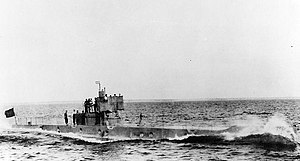 L-5 underway L-5 underway
| |
| History | |
|---|---|
| Name | USS L-5 |
| Builder | Lake Torpedo Boat Company, Bridgeport, Connecticut |
| Laid down | 14 May 1914 |
| Launched | 1 May 1916 |
| Commissioned | 17 February 1918 |
| Decommissioned | 5 December 1922 |
| Fate | Sold for scrap, 21 December 1925 |
| General characteristics | |
| Type | L-class submarine |
| Displacement |
|
| Length | 165 ft (50 m) |
| Beam | 14 ft 9 in (4.50 m) |
| Draft | 13 ft 3 in (4.04 m) |
| Installed power |
|
| Propulsion |
|
| Speed |
|
| Range |
|
| Test depth | 200 feet (61.0 m) |
| Complement | 28 officers and enlisted men |
| Armament |
|
USS L-5 (SS-44) was an L-class submarine built for the United States Navy during the 1910s.
Description
The L-class boats designed by Lake Torpedo Boat (L-5 through L-8) were built to slightly different specifications from the other L boats, which were designed by Electric Boat, and are sometimes considered a separate L-5 class. The Lake boats had a length of 165 feet (50.3 m) overall, a beam of 14 feet 9 inches (4.5 m) and a mean draft of 13 feet 3 inches (4.0 m). They displaced 451 long tons (458 t) on the surface and 527 long tons (535 t) submerged. The L-class submarines had a crew of 28 officers and enlisted men. They had a diving depth of 200 feet (61.0 m).
For surface running, the boats were powered by two 600-brake-horsepower (447 kW) diesel engines, each driving one propeller shaft. When submerged each propeller was driven by a 400-horsepower (298 kW) electric motor. They could reach 14 knots (26 km/h; 16 mph) on the surface and 10.5 knots (19.4 km/h; 12.1 mph) underwater. On the surface, the Lake boats had a range of 5,150 nautical miles (9,540 km; 5,930 mi) at 11 knots (20 km/h; 13 mph) and 150 nmi (280 km; 170 mi) at 5 knots (9.3 km/h; 5.8 mph) submerged.
The boats were armed with four 18-inch (450 mm) torpedo tubes in the bow. They carried four reloads, for a total of eight torpedoes. The L-class submarines were also armed with a single 3"/50 caliber deck gun.
Construction and career
L-5's keel was laid down on 14 May 1914 by Lake Torpedo Boat Company in Bridgeport, Connecticut, launched on 1 May 1916, sponsored by Mrs. Rosalind Robinson, and commissioned on 17 February 1918. After exercises along the Atlantic coast, L-5 departed Charleston, South Carolina, on 15 October 1918 with Submarine Division 6 and reached the Azores on 7 November. Following the Armistice with Germany on 11 November, L-5 headed west, arriving Bermuda on 1 December. She participated in exercises in the Caribbean Sea before steaming on to San Pedro, California, where she arrived 13 February 1919.
From 1919 to 1922, she remained on the West Coast experimenting with new torpedoes and underseas detection equipment. L-5 departed San Pedro on 25 July 1922, and, after visits in Mexico, Nicaragua, and the Panama Canal Zone, she arrived Hampton Roads, Virginia, on 28 September. The submarine remained there until she decommissioned on 5 December 1922. She was sold on 21 December 1925 to Passaic Salvage and Reclamation Company in Newark, New Jersey, and scrapped.
Notes
References
- Friedman, Norman (1995). U.S. Submarines Through 1945: An Illustrated Design History. Annapolis, Maryland: Naval Institute Press. ISBN 1-55750-263-3.
- Gardiner, Robert & Gray, Randal, eds. (1985). Conway's All the World's Fighting Ships 1906–1921. Annapolis, Maryland: Naval Institute Press. ISBN 0-85177-245-5.
 This article incorporates text from the public domain Dictionary of American Naval Fighting Ships. The entry can be found here.
This article incorporates text from the public domain Dictionary of American Naval Fighting Ships. The entry can be found here.
External links
- Photo gallery of USS L-5 at NavSource Naval History
| United States L-class submarines | |
|---|---|
| Electric Boat design | |
| Lake Torpedo Boat design | |